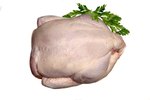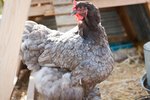Things You'll Need
Enclosed 10 x 10 area for each 10 poults
Wood shavings, straw or hay
Heat lamp if raising more than 10 poults
Hanging feeder
Chicken water fountain
Poultry feed (rations) for each phase of growth
Poults
Poultry fencing
Poultry fencing stakes
Poultry cages
Warnings
Turkeys are susceptible to blackhead disease, airsacculitis and coccidiosis. Most hatcheries can inoculate poults for these diseases prior to shipment or provide the inoculations separately.
Tips
Allowing turkeys to graze in a pasture is optional. It requires farmers to put up poultry fencing in the area where the birds will graze. Birds should be brought back indoors at night if there are predators in the area.
A shelter should be available in the pasture for inclement or hot weather. A waterer should also be available if there is no other water source.
For larger turkey operations, debeaking the birds is desirable. This is done when they are a week or so of age. This prevents cannibalism, which is common in large flocks.
Starting a turkey farm can be a great money making opportunity for a farmer. However, raising turkeys isn't always easy. The saying is that a turkey will look for a reason to die, instead of looking for a reason to live. To be successful, it is important to start with healthy poults (young turkeys), the cleanest living arrangements and the very best feed. This will ensure that your turkeys are healthy and the operation profitable.
Employ a butcher for your poultry. Turkey farmers have to make arrangements with butchers ahead of raising the turkeys so they will have the resources available when it is time to dress them.
Prepare the area in which the poults will be housed. It should be clean and draft free. Each turkey will require at least one square foot of space. Clean wood shavings, straw or hay should be placed on the floor. A heat lamp should be hung two feet above the pen. A water fountain and a feeder should be placed in the pen. Starter ration should be on hand for the arrival of the poults.
Decide what type of turkeys are you going to raise and place an order from a reputable hatchery. There are two choices: heritage or white-breasted turkeys. When heritage turkeys are dressed, there are black dots on the skin where the feathers were removed. White breasted turkeys are preferred because they will have all white skin. Poults will be delivered within two days of hatching.
When the poults arrive, place them in their new home quickly. The heat lamp should be on and there should be fresh water and feed available. The chicks need to have their beaks dipped in the water upon arrival to ensure they know where the water source is. After the first few hours they will then begin to drink water and eat by themselves.
Remove the heat lamp and switch to grower ration when the poults are approximately eight weeks of age. The birds may also be put in a pasture during the day in warmer climates.
Put the turkeys on a finishing ration at 14 weeks of age. The birds will be ready for dressing at 22 to 28 weeks of age, depending upon sex and breed. If the birds will be dressed at another location, poultry cages will be required for their transport.
References
Resources
Tips
- Allowing turkeys to graze in a pasture is optional. It requires farmers to put up poultry fencing in the area where the birds will graze. Birds should be brought back indoors at night if there are predators in the area.
- A shelter should be available in the pasture for inclement or hot weather. A waterer should also be available if there is no other water source.
- For larger turkey operations, debeaking the birds is desirable. This is done when they are a week or so of age. This prevents cannibalism, which is common in large flocks.
Warnings
- Turkeys are susceptible to blackhead disease, airsacculitis and coccidiosis. Most hatcheries can inoculate poults for these diseases prior to shipment or provide the inoculations separately.
Photo Credits
-
Turkey image by Filev from Fotolia.com





